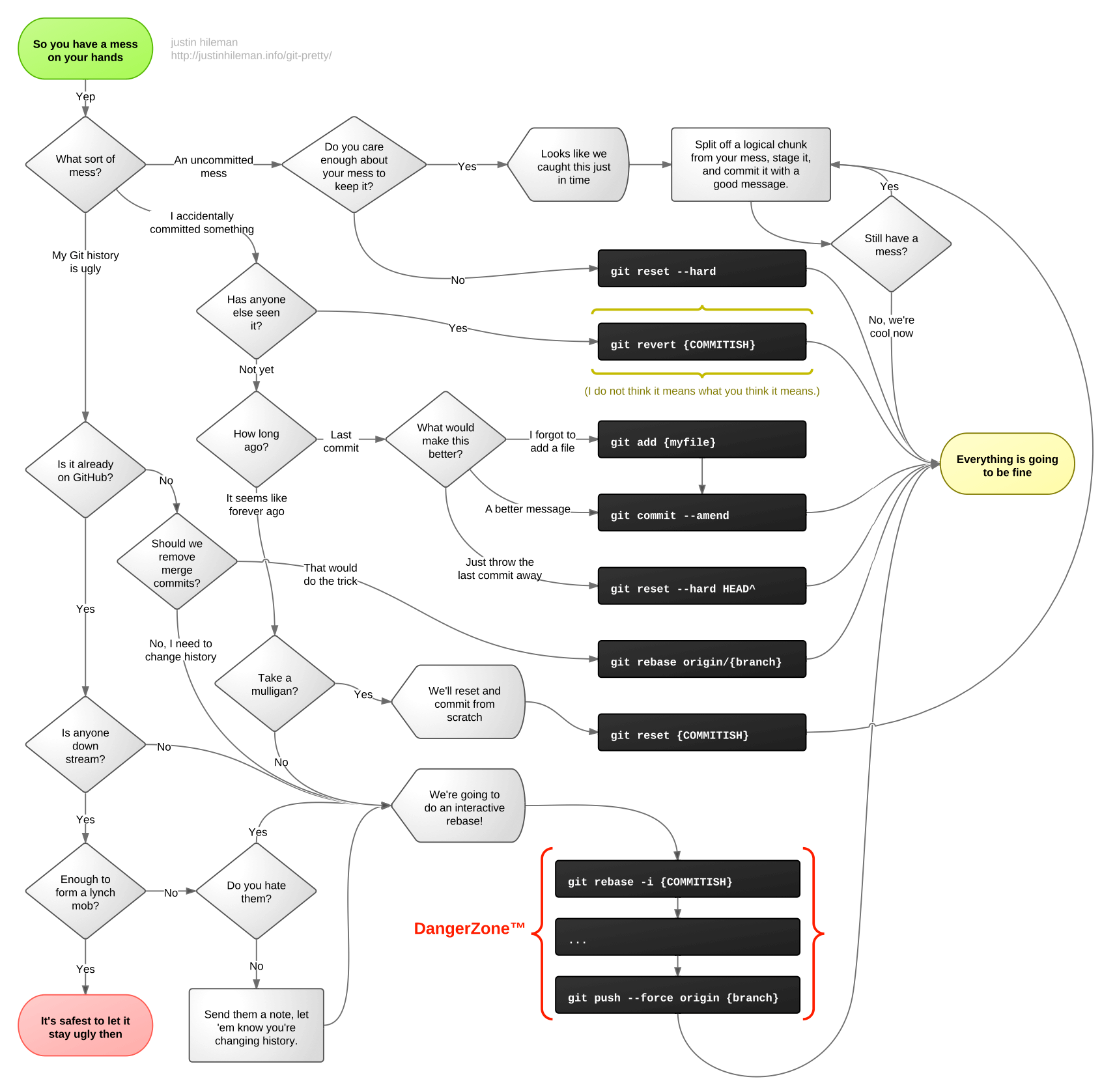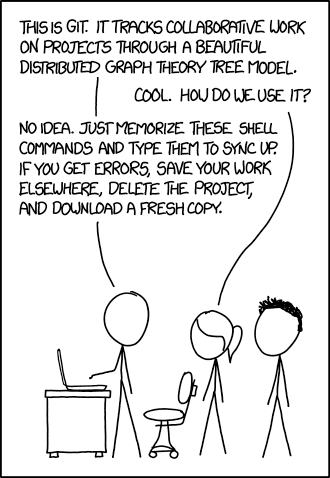November 8, 2016 Development Git
Some Git Help
I shared some information at a Lunch and Learn along with a demo and now I’m sharing it with you.
What is Git?
“Git is a free and open source distributed version control system designed to handle everything from small to very large projects with speed and efficiency.
Git is easy to learn and has a tiny footprint with lightning fast performance. It outclasses SCM tools like Subversion, CVS, Perforce, and ClearCase with features like cheap local branching, convenient staging areas, and multiple workflows.” ~ https://git-scm.com/
Watch Scott Hanselman’s Computer Stuff They Didn’t Teach You #4 - Git 101 Basics . 33 minutes, He talks about what Git is and shows git in the command line and using VS Code.
“branching as a tool vs branching as a strategy” ~ Scott a branch is a playground
new task = new branch, use Pull Requests to get the code into master
- or allow direct check-in to master (for 1 or 2 person teams?)
checkout a branch with git checkout myBranch
create and checkout the branch with git checkout -b myNewBranch
A taskNumber in comment will link up to a TFS task.
Command Line
get latest = git pull
check in = git add -A (stage), git commit -m "commit message" (repeat), git push
git checkout is switching the branch
to automatically prune branches that are no longer in remote on fetch use:
git config remote.origin.prune true from
StackOverflow question
your force push will only complete if the upstream branch has not been updated by someone else
git push --force-with-lease
Re-basing / Standard Workflow
I use this approach with re-basing when I am working on a branch on my own and need to get the latest from master into my branch. This replay’s your commits on top of the master branch. Another way to say it, is that git pretends your changes were made after the master’s latest changes.
You may have to merge, but the more often you update your branch, the less painful the merges.
git checkout master
git pull
git checkout myBranch
git rebase master
(deal with merging, use git rebase –continue)
git push --force // VS doesn’t do this
git ..master karma.conf.js (compare your branched code against master)
rebase or merge? http://stackoverflow.com/questions/804115/when-do-you-use-git-rebase-instead-of-git-merge . I prefer rebase when I’m the only one working on the branch.
Here’s a good walk-through of merging vs rebasing with graphics . “Once you understand what rebasing is, the most important thing to learn is when not to do it. The golden rule of git rebase is to never use it on public branches.”
When should I rebase?
We had a rebranding branch (changing the whole UI), then had to fix some things in master. We had moved folders and other changes in the rebranding branch, so the git rebase master gave us the same merge conflicts over and over. At the end we still didn’t have it correct. git merge master let us resolve the conflicts once, commit that change and move on.
Active PR
I have an active PR and I want to start work based on the PR branch. What’s the best way to do that? In the past I’ve branched off the PR branch, but then when the PR completes it seems like there are a lot of conflicts when re-basing from master
Scott to the rescue!
“That’s where the –onto helps out”
git rebase --onto master pr-branch pr-and-more
“It figures out the set of commits that happen between pr-branch and pr-and-more, and then replays those onto master”
“Running just git rebase pr-and-more master will have git find where pr-and-more diverged from master (which means it grabs everything from your pr-branch), and replay that whole set of commits onto latest master.”
Note: git rebase --onto master pr-branch is also useful. It seems to skip having to merge every commit.
I suggest doing git branch myBackup so you can cherry pick if something gets lost
Use Pull Requests
I recommend turning off permissions to check into master, expect for a select few how, in a rare scenario, may need to fix up that branch.
One possible work flow is to only have code merge into master through Pull Requests.
Run you “gated” builds before allowing the PR to be completed.
Setup approval policies where one or more need to approve the PR before it can be completed and merged into master.
Pull Requests with code reviews helps keep code quality high and continual learning and sharing of information. Scott Nonnenberg has some tips on doing a good pull request review.
I don’t know about the exact numbers, but Eric Elliot has a good insight “Code review, collaboration, and knowledge sharing (each hour of code review saves 33 hours of maintenance)”.
VSTS/TFS has some nice tools for Pull Requests .
VIM
- http://bullium.com/support/vim.html
- get away from VIM (since I don’t know the keyboard shortcuts this was necessary for me):
Having Problems?
 from
http://justinhileman.info/article/git-pretty/git-pretty.png
from
http://justinhileman.info/article/git-pretty/git-pretty.png
Some Benefits of Git
- Developer productivity and collaboration
- Git is faster to pull in changes
- Command line can be a lot faster than using a mouse in Source Control explorer
- There is less reliance on a centralized server that may cause lag
- Moving and renaming files is much easier and faster
- Work can continue if ADO/VPN or internet is down
- Git branches can be worked on at the same time together when necessary
- Enable mini-experiments with small local commits and quick undo of that action
- Build times: with a experiment in Git, the checkout for git was 18 seconds, vs 1 min 4s on TFVC
- Git is faster to pull in changes
- One directory on your hard-drive
- Git branch is a diff, not a completely different folder
- The code review process is greatly improved with Pull Request and the ADO built in web UI
- Check out my long list of frustrations using his experience using SourceSafe, SVN, TFVC, Git and back to TFVC over the years: https://www.aligneddev.net/blog/2019/i-like-git-over-tfvc/
Available Training
Recommended
- https://docs.microsoft.com/en-us/learn/modules/intro-to-git/
- https://git-scm.com/book/en/v2
- https://learngitbranching.js.org/
- Pull Requests in Azure DevOps: https://docs.microsoft.com/en-us/azure/devops/repos/git/pull-requests-overview?view=azure-devops
- Visual Studio 2019 tools make it much like using TFVC
- https://docs.microsoft.com/en-us/azure/devops/repos/git/gitquickstart-vs2015?view=azure-devops&tabs=visual-studio
- https://docs.github.com/en/github/getting-started-with-github/git-cheatsheet
Other options
- https://try.github.io/
- https://git-school.github.io/visualizing-git/
- https://app.pluralsight.com/library/courses/git-fundamentals/table-of-contents
- https://app.pluralsight.com/library/courses/mastering-git/table-of-contents
- https://app.pluralsight.com/library/courses/azure-devops-continuous-delivery-source-control
- https://mohamedradwan.com/2019/05/31/mastering-git-from-beginner-to-advanced-step-by-step-with-graphical-animation-commands/
- https://docs.microsoft.com/en-us/azure/devops/learn/devops-at-microsoft/use-git-microsoft
- https://docs.microsoft.com/en-us/azure/devops/repos/git/gitquickstart
- Using VS Code:
- Git in Visual Studio Code - video
- https://code.visualstudio.com/Docs/editor/versioncontrol
- The New Git Experience: https://youtu.be/ZiQ2LXtAJ6I in Visual Studio
Credentials
https://git-scm.com/book/en/v2/Git-Tools-Credential-Storage
More Links
- https://services.github.com/kit/downloads/github-git-cheat-sheet.pdf
- http://learngitbranching.js.org/
- https://www.codeschool.com/courses/try-git
- https://www.visualstudio.com/en-us/docs/git/gitquickstart
- https://git-scm.com/book/en/v2
- https://www.pluralsight.com/courses/git-fundamentals
- https://blogs.msdn.microsoft.com/luisdem/2016/10/18/net-core-git-vsts-vscode/
- http://blog.kablamo.org/2013/12/08/git-restore/
- https://git-school.github.io/visualizing-git/
- https://dev.to/chrisachard/confused-by-git-here-s-a-git-crash-course-to-fix-that-4cmi
- You might want to add .gitattributes
- Git AutoCorrect
- Scott Hanselman’s Git 101
XKCD is relevant here: https://imgs.xkcd.com/comics/git.png

This was originally posted on my GeeksWithBlogs.net/aligned blog.
Please consider using Brave and adding me to your BAT payment ledger. Then you won't have to see ads! (when I get to $100 in Google Ads for a payout, I pledge to turn off ads)

Also check out my Resources Page for referrals that would help me.
Use Swan Bitcoin to onramp with low fees and automatic daily cost averaging and get $10 in BTC when you sign up.